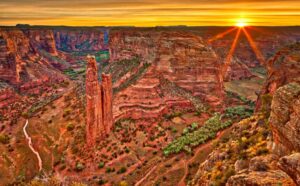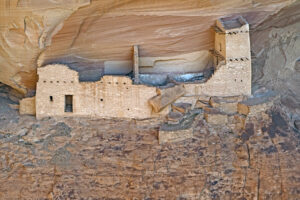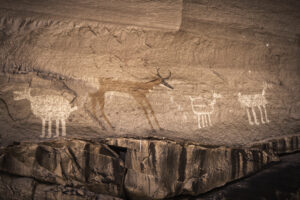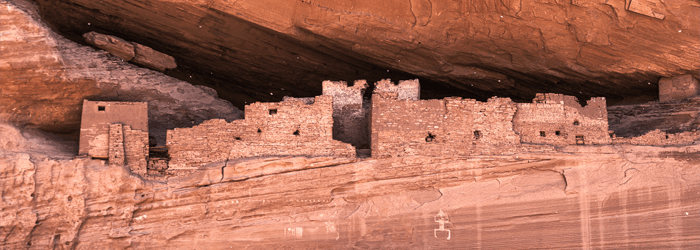Canyon de Chelly
A Hiker’s & History Buff’s Paradise
Located in Apache County, in the northern portion of Arizona’s Navajo Nation, Canyon de Chelly, a national monument, is a dream for hiking enthusiasts and history buffs.

The Navajo name for this area is Tséyi’ (pronounced “say-yih”), translating to “within the rock” or “deep in the rock.” The name Canyon de Chelly comes from the Spaniards’ attempt to pronounce Tséyi’ and adding cañón as a noun. Today we pronounce it de-shay.
For nearly 5,000 years, people have lived in these canyons – longer than anyone has lived uninterrupted anywhere on the Colorado Plateau. The ruins of ancient homes and petroglyphs tell us their stories. Today, Navajo families make their homes, raise livestock, and farm the lands in the canyons.
A Brief History of Canyon de Chelly
With pueblo ruins built between 350 and 1300 A.D., Canyon de Chelly long served as a home for Navajo people before it was invaded by forces led by future New Mexico governor Lt. Antonio Narbona in 1805. In 1863, Col. Kit Carson sent troops through the canyon, killing 23 Indians, seizing 200 sheep, and destroying hogans and crops. The resulting demoralization led to the surrender of the Navajos and their removal to Bosque Redondo, New Mexico.
Canyon de Chelly National Monument was authorized in 1931 by President Herbert Hoover to preserve its archeological resources. The monument encompasses approximately 84,000 acres of land located entirely within the Navajo Nation with roughly 40 families residing within the park boundaries. The National Park Service and the Navajo Nation share resources and continue to work in partnership to manage this special place.
Visitors may travel in the canyons only when accompanied by a park ranger or an authorized Navajo guide. The one exception to this rule is the White House Ruin Trail.
Climate
This high desert is located at an elevation of 5,000 to 6,000 feet. The temperature can fluctuate as much as 40 degrees in a day. In the summer, temperatures reach higher than 100 degrees and below freezing on winter nights. Because Canyon de Chelly experiences summer monsoons, be prepared in the late summer for isolated thunderstorms. Pack a rain poncho, sunscreen, hat, sunglasses, and a lot of water when sightseeing in this area. Heed flash flood warnings.
Things to Do & See
There is no shortage of things to do and see.
Hike or bike the 130-mile loop road around the canyon for a bird’s eye view of its crimson-red walls and cliffs, lush green cottonwood trees, livestock, cornfields, and homes dotting the canyon’s floor. While hiking, keep your eyes peeled for ruins and petroglyphs throughout the canyon.
 Most park visitors arrive by car and view Canyon de Chelly from the rim, following both North Rim Drive and South Rim Drive. Ancient ruins and geologic structures are visible in the distance from turnoffs.
Most park visitors arrive by car and view Canyon de Chelly from the rim, following both North Rim Drive and South Rim Drive. Ancient ruins and geologic structures are visible in the distance from turnoffs.
Two self-guided drives extend from the visitor center and follow the rims of the canyon. Bring your binoculars.
Private Navajo-owned companies offer tours of the canyon floor by horseback, hiking, or four-wheel-drive vehicle. Click here for a list of Navajo Nation-approved touring companies.
Aside from tour fees, there is no entrance fee to enter the park.
The monument is open daily, sunrise to sunset, year-round. The Visitor Center is open daily, from 8:00 a.m. to 5:00 p.m., and closed on Thanksgiving, Christmas, and New Year’s Day. Before heading there, verify their hours on their website.
Lodging & Dining
There are many campsites in the Cottonwood Campground and Spider Rock Campground. Hotels are available in Chinle including Thunderbird Lodge which includes a restaurant and trading post. Check out Junction Restaurant as another dining option.
 Fun Facts
Fun Facts
- There are as many as 800 known archaeological sites within the national monument.
- Spider Rock, the 750-foot spire that rises from the canyon’s floor, is home to and named after Spider Woman. In the Navajo creation story, she is a holy person who brought creation and beauty to the Navajo people, most notably through weaving.
- The nearly 84,000 acres are Navajo Tribal Trust Land and are under the jurisdiction of the Navajo Nation. It is the only national park or monument to operate in this way.
- The National Monument was listed on the National Register of Historic Places on August 25, 1970.
Intrigued? Watch this video for Staycation inspiration!
Register To Win The Staycation
###
Photo Credit
- Shutterstock
Related Content
- Oatman, Arizona | Lore, Legends, and Burros
- Bullhead City | An Oasis for Water Lovers & Desert Rats
- Visit Arizona
- Only In Your State
- National Park Service
- Wikipedia
















